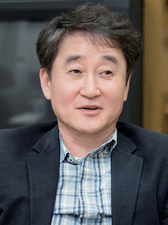KIM Hyeong-gu is one of the most prolific cinematographers, having to his credit a large number of films since the mid-1990s. Born in 1960, he studied at the American Film Institute and later at the Korean Academy of Fine Arts before starting his career as a cinematographer in 1994 with the drama film <A Casual Trip>. He gained notoriety for the cinematic techniques he employed in the cult youth drama film <Beat> (1997), such as close-ups with a wide angle lens to...
More
KIM Hyeong-gu is one of the most prolific cinematographers, having to his credit a large number of films since the mid-1990s. Born in 1960, he studied at the American Film Institute and later at the Korean Academy of Fine Arts before starting his career as a cinematographer in 1994 with the drama film <A Casual Trip>. He gained notoriety for the cinematic techniques he employed in the cult youth drama film <Beat> (1997), such as close-ups with a wide angle lens to create distortion or the step printing effect, which were unconventional for the Korean industry of the time. His efforts were recognized with a Best Cinematography award from the Korean Association of Film Critics. KIM further built his reputation through collaborations with BONG Joon-ho, LEE Chang-dong and HONG Sang-soo. After helping <A Peppermint Candy> (1999) turn into the classic it has become today with some of the most memorable images in a Korean film, he shot in Manchuria the China-Korea co-produced war epic <Musa-The Warrior> (2001). This first step into the Chinese market allowed him the next year to work with CHEN Kaige on <Together> (2002). With <Memories Of Murder> (2003), he successfully conveyed the anxiety and fear that permeates a village struck by a serial killer. He was reunited with BONG a few years later for <The Host> (2006). Starting with <Woman Is The Future Of Man> (2004), he has worked on several of HONG Sang-soo’s works including the award-winning <On the Beach at Night Alone> (2016) and <The Day After> (2017), and even introduced in <Tale of Cinema> (2005) the zooms that would become HONG’s well-known signature. In 2014, he worked for the first time with IM Kwon-taek for <Revivre> (2014).
Less






